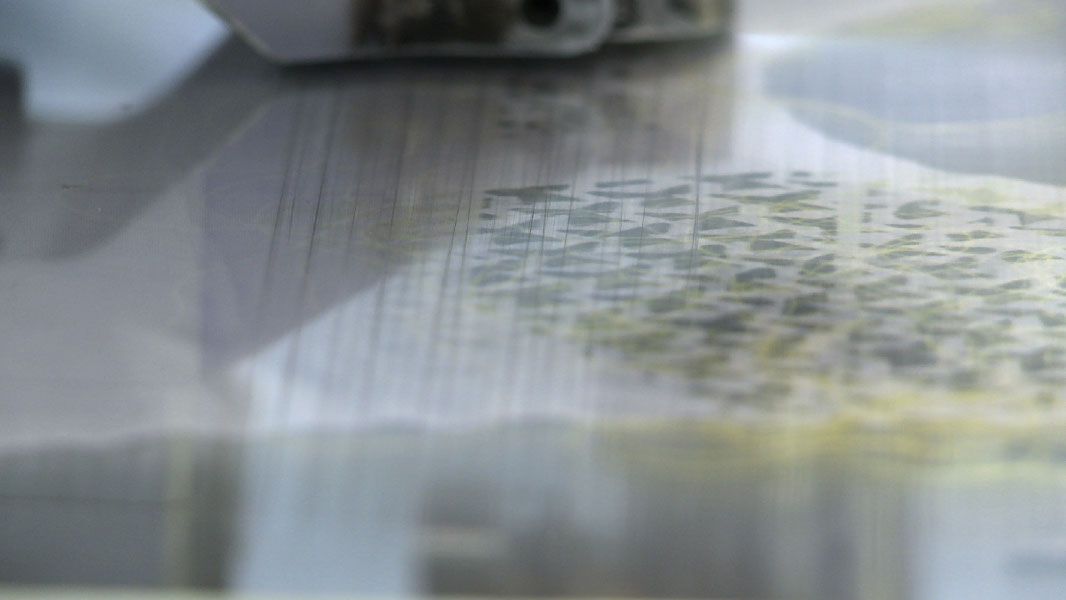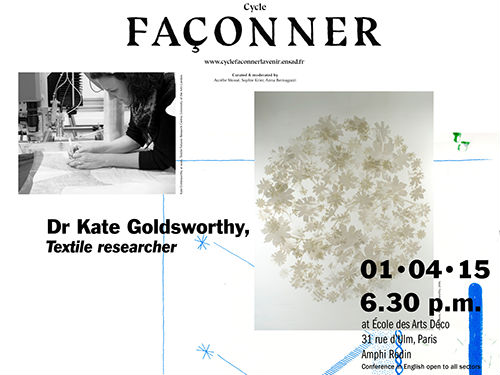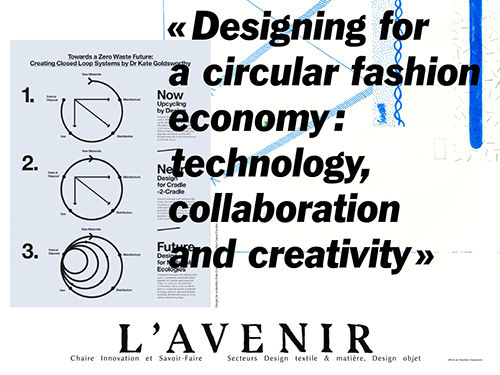BIO
Dr Kate Goldsworthy is Senior Research Fellow at the University of the Arts London in ‘Textiles Environment Design’ (TED) at Chelsea and a lead researcher with the ‘Textile Futures Research Centre’ (TFRC). With almost 20 years of experience as a textile designer, consultant and academic, her core interests are design for cyclability, new finishing and production technologies and material innovation.
Her practice-based PhD entitled ‘Laser-finishing: a new process for designing recyclability in synthetic textiles’, re-imagined the way we could manufacture and re-manufacture textiles with a focus on ‘industrial ecology’ and 'life-cycle design'. Her current work continues to explore these themes, proposing more sustainable production systems for the textile industry, and pioneering design solutions for the recycling and reuse of polyesters. She has contributed to international publications, conferences and exhibitions including ‘Trash Fashion’ at the Science Museum, ‘Well Fashioned’ at the Crafts Council, (London), and ‘ReThink!’ at the Audax Textile Museum (Tilburg).

Outline of talk:
The future of the textile and fashion industry relies on designers creating new, compelling visions for the way in which products are created, used and disposed of. Designers need to think radically about the materials that they are using and the form and purpose they are giving them.’ In this lecture Goldsworthy will present recent research projects exploring ‘Designing for Cyclability’. Whether working with material scientists to develop a ‘fast-fashion’ friendly, bio-recoverable paper cloth or with engineers to develop a new digitally driven production and finishing technology for recyclable synthetic textiles, her approach is practice based, always placing the ‘prototype’ at the centre of her research, and collaborative, often across disciplines in both industry and scientific fields.
She will also present projects from the recently completed research for Mistra Future Fashion (towards systemic change in the fashion industry) including prototypes created for the online exhibition Textile Toolbox which launched in November 2014. The resulting works demonstrate the potential for progressing a sustainable fashion system with new materials, processes, applications, consumer interfaces and business models. The exhibits are a starting point for discussion – provocations, or ‘provotypes’ – showing us how design tools can create entirely new visions for the future of the industry.
Selected Bibliography (Authored Papers)
2014 The case for transforming the approach to waste and growing a circular economy; a design perspective, written evidence submitted to the UK Parliamentary Commission on 'Growing a Circular Economy' [Full report and transcripts available here]
2014 Design for Cyclability: pro-active approaches for maximising material recovery, Making Futures Vol 3 ISSN 2042-1664. Presented at Making Futures Conference, Plymouth University (October 25th-26th 2013) http://makingfutures.plymouthart.ac.uk/
2011 Borrowed Materials; laser-finished textiles for a closed-loop polyester economy, Presented at Sustainability in Design: NOW! Challenges and opportunities for Design Research, Education and Practice in the 21st Century, Published Paper, Bangalore, India
2010 Without a Trace, Commissioned article for Viewpoint Magazine, Issue 26; The New Normal (co-authored with Dara Lang) pp108-115


fictive intro by Geoffrey Hillereau
"After staying a few years in Cambodia, I have been hurt and bruised in Paris, by the presumptuous indelicacy of Karl, John, Jean-Paul or even Marc, those legendary executioners of drape, who pull about both fabric and models, and cut and disregard them without paying any attention to their feelings. A few years ago, I seized the opportunity to leave the airtight world of high fashion, this elitist capsule which, since decades, only needs my fellows for their colours and decorative qualities. Thus while my brothers, in some dark Vietnamese factories, where laser cut, graft to Levi’s fake holes jeans made by 8 years old kids, I was planning my escape. The system of big production and fashion would soon become a distant memory, I hoped. Undervalued and despised for far too long, it is as an industrial refugee that I was received at FIRE : The Fashion Innovation Research and Enterprise. In this institute, dedicated to textile rehab as a vector of innovation in clothing, I met the woman who reinvented me. It is also her who made me feel like an important actor in sustainable innovation, leaving behind my archaic decorative enslavement.
I am a natural plant fiber, and I am honoured to present you Kate Goldsworthy."